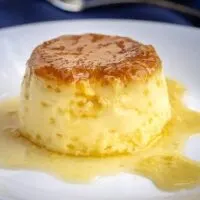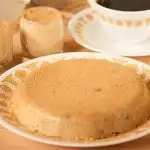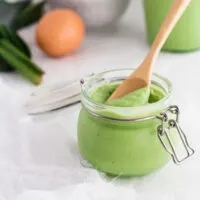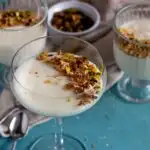Rožata is a Croatian version of a caramel flan baked custard. It boasts a beautiful presentation, with a golden top over the creamy, orange and vanilla flavored custard.
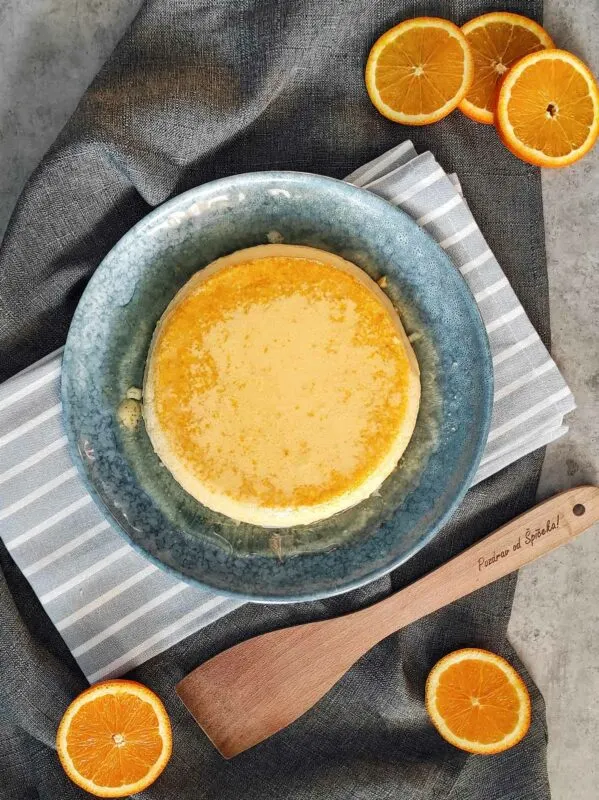
Croatian deserts
There are some recipes that are just special, not only because of their amazing flavors and aromas but also because of their appearance, especially when it comes to desserts.
In Croatia, a lot of effort is invested into both the taste and the aesthetic because hey, desserts have the closing act of every gastronomy experience, and it needs to be a great act!
For example, torta hrapačuša, which is prepared on the island of Brač, has a top coat made of walnuts which resembles a specific stone from that island.
Another, Rab’s cake, has a title of one of the most beautiful traditional cakes. Its dough is shaped in an extravagant snail shell. It looks simply elegant.
Besides those 2 cakes, the cake from Imotski is often called the queen because it comes with a crown made of almonds.
Such beauty! Not to mention how delicious these cakes are. Each is special in its own way, but they certainly have one thing in common – rich flavors!
In Croatia, cakes aren’t the only beautiful, aesthetic, and delicious sweets. In the southern parts of the country, there is one very simple dessert, but yet, it is so elegant and glamorous that you really can’t stop admiring it.
It is called rožata. And to me, it is a true queen of all the desserts.

Traditional Sweets of Dalmatia
The Croatian region of Dalmatia is known for its simple but rich-in-flavors cuisine.
We’ve already talked about its amazing Mediterranean cuisine when we were preparing komiška pogača and žrnovski makaruni. So today, we are going to talk about the basis of the Dalmatian desserts.
Dalmatian desserts are made with just a few everyday ingredients such as eggs, flour, and sugar. As well as classic Mediterranean fruits, such as dried figs, raisins, almonds, and more.
For example, two of the simplest Dalmatian desserts are called arancini and limuncini. They are candied orange and lemon peel. Simple, right? But the sweetness of the sugar beautifully combines with the bitter peel of these two Mediterranean fruits.
Simpleness and imagination are the key factors when it comes to traditional Dalmatian sweets, cakes, and cookies.
Besides the already mentioned arancini and limuncini, Dalmatia truly has a beautiful and rich selection of sweets.
Lumblija is a simple sweet bread which is only prepared in the 2 towns on the island of Korčula called Blato and Vela Luka. (Lumblija also has an amazing love story behind its recipe so who can resist that!)
Paprenjaci or paprenjoci are traditional honey-made cookies from the island of Hvar.
Trogirski rafioli are little almond filled cookies made by a 150-year-old recipe.
Mandulat or bademovac, a nougat candy made with only 4 ingredients and placed between 2 oblatne (wafers).
All these recipes require just a couple of ingredients in order to offer beautifully combined aromas and nuances.
Of course, they may be simple, and they may need just a couple of ingredients for preparing, but the final results, flavors, aromas, and nuances won’t be that easy to forget.
Besides all the mentioned desserts (and many more), there is one particular sweet recipe that looks aesthetic and tastes divine.
Are you ready for rožata?

A Dessert Of The Past & Present
Rožata is a traditional Dalmatian pudding with caramel topping. Its recipe dates to the 12th century.
It is similar to Italian crème caramel, French crème brûlée, and Spanish flan, but even though all these desserts are similar, they have some differences in the ingredients.
Rožata comes in a couple of forms in Croatia and due to that, you won’t try the same recipe on the island of Korčula, Hvar, or Brač. But that is the beauty, isn’t it?
When it comes to its official origin, rožata came from Dubrovnik, and there, people call it rozata. It got its name after rosalin – a rose petal liqueur which is one of the main ingredients of the original recipe.
The first records of rožata, rozata, or rožada dates back to the time of the Venetians. In the 1300s, it was called the friar’s pudding.
From then until now, a lot has changed in the country. Many civilizations came, influenced, and left, but the old recipe for rožata was carried on from one generation to the other. So today, this dessert presents a beautiful Dalmatian heritage.
Rožata is a simple recipe that requires milk, eggs, sugar, vanilla aroma, brandy, orange peel, and water. That’s it.
In the end, all the flavors beautifully combine, with a bitter touch of the orange peel and sweet caramel topping, in order to create a true ecstasy of all the aromas.
The mentioned ingredients are used in the classic and traditional recipe from the Dalmatian coast and islands. But, in case you want to make it by the old recipe from the town of Dubrovnik, just use a rose petal liqueur instead of a brandy!
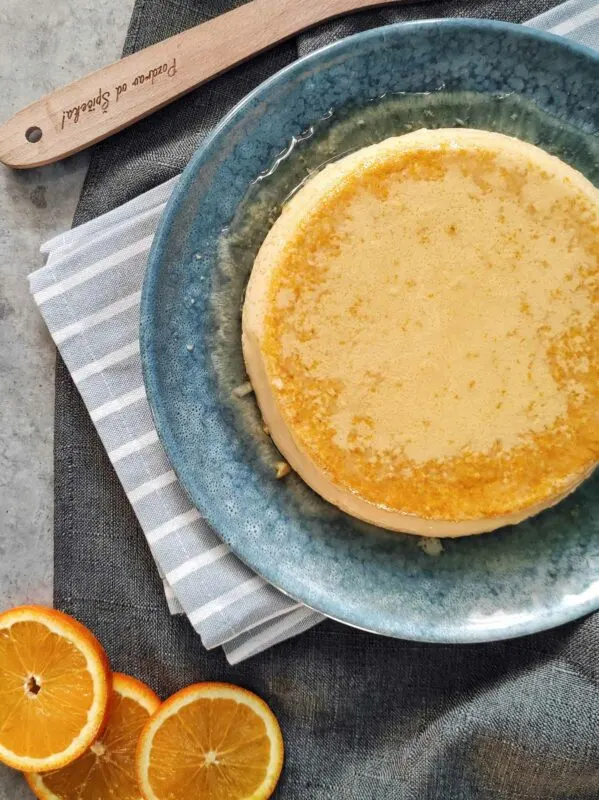
How To Prepare Rožata
In order to make this simple, yet delicious dessert, you just need a couple of the already mentioned ingredients.
What is important is to make caramel first.
Now, if you’re making caramel for the first time from scratch, don’t be scared. It is really simple to make. Just make sure to stir the mixture made from sugar and water on a low fire.
Once the mixture gets light brown in color, remove it immediately from the fire and pour into the bowl(s) in which you’ll be baking the rožata. (Of course, the bowl needs to be suitable for the oven so make sure you’re using oven-safe bowl(s).)
You can make rožata in 3 smaller bowls or one larger. I have done it both ways, so it only depends on your preferences.
Baking in a water bath
Now, the baking process – you need to place the bowl(s) with the mixture in a baking dish and fill it with water until the level is half way up the custard bowl(s).
This water bath creates a gently baking process to create a smooth and creamy custard.
Serving this caramel orange flan
Once the rožata is done and chilled, it needs to be turn upside down on the serving plate.
Be brave for this step, I know it is not easy to do, but just go for it. Quickly and simply – I assure you, rožata will be strong!
But to ease up this turning process, do run a thin knife along the edges before turning.

And that’s it with the specific preparation guide! You’re ready for the recipe now!
Rožata (Croatian Caramel Flan)
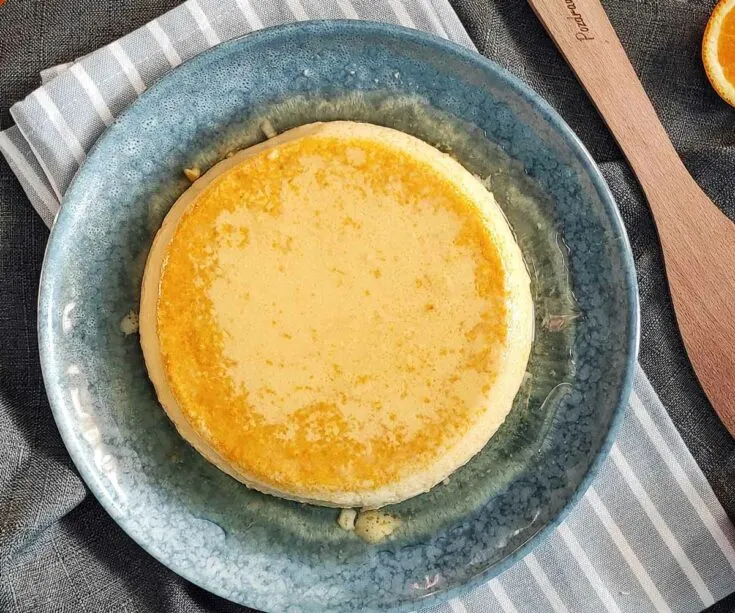
Rožata is a Croatian version of a caramel flan baked custard, with a golden top over a creamy, orange and vanilla flavored custard.
Ingredients
For the caramel
- 6 Tbsp sugar
- 2 Tbsp water
For the custard
- 5 eggs
- 5 Tbsp sugar
- Pinch of salt
- 1 Tbsp brandy*
- 1 Tbsp vanilla extract
- 2 organic oranges**, zested
- 500 ml (2 c + 2 Tbsp) milk
- Water (for the water bath)
Instructions
- Preheat your oven to 180°C (350°F).
For the caramel
- Put 6 tablespoons of sugar and 2 tablespoons of water into a small saucepan over low heat.
- Stir the mixture until the sugar dissolves and your caramel turns a light brown color.
- Pour the caramel into one larger (7-8 inch diameter) or 3 smaller (roughly 4 inch) ramekins, to coat the bottom. (Bowls should be at least 2 inches deep.) Set aside.
For the custard
- In a medium bowl, beat the eggs, 5 tablespoons of sugar, and a pinch of salt until light and foamy.
- Add the brandy, vanilla extract, and orange zest. Mix until combined.
- Pour the custard mixture into the caramel-coated ramekins(s).
- Place the filled ramekins into a deeper baking dish.
- Pour water into the baking dish until it comes halfway up the sides of the ramekins.
- Bake the rožata in the water bath for 45 minutes.
- Once the custards have set (you can test this by sliding a butter knife into the center of one - if it comes out clean, it's done), remove the dish from the oven and carefully remove the custards from the water bath. Let them cool on a wire rack.
- Once cool, and just before serving, gently run a knife around the edges to loosen them slightly and gently turn the custards upside down onto a serving platter.
Notes
*If you you would like to make this dessert by the old recipe from the town of Dubrovnik, use a rose petal liqueur instead of a brandy.
**When using the zest of citrus fruits, we prefer to choose organic to avoid consuming the fungicides and colorants that are sprayed on conventional citrus after harvesting.
Nutrition Information:
Yield:
3Serving Size:
1/3 of recipeAmount Per Serving: Calories: 364Total Fat: 8g
If you liked this recipe, here are some similar dishes you may enjoy!

Ana has a bachelor’s degree in journalism, and she has received a Rector’s award for achievements during her studies. She is an experienced writer for restaurants and wineries, and she loves to cook, research, and experiment with different cuisines and ingredients. Besides writing, Ana loves to photograph and travel, especially to Korčula, Croatia which is her second home and the best inspiration for new recipes and flavors.
